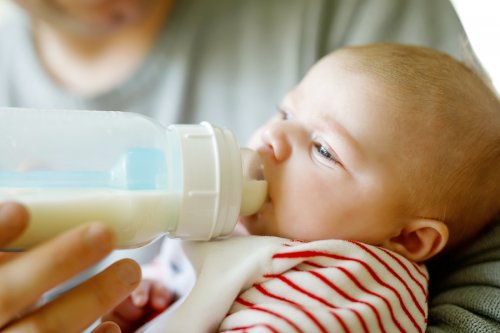How Much Milk Should Babies Drink?

Before you become overwhelmed, rest assured that there are indications that show whether or not your little one is being well-fed. Take note and enjoy as your baby grows strong and healthy.
How to know how much milk your baby should drink
First and foremost, it’s important to know that the World Health Organization recommends exclusive breastfeeding until 6 months of age. The reason is because a mother’s breast milk contains everything a baby needs to grow healthy and strong.
Therefore, there is no specific quantity of milk that your baby needs to drink. Rather, you should nurse as often as your baby wants.
There are certain situations that require feeding with formula. Of course, your child’s pediatrician is the one who will provide you with precise indications about feedings.
However, you can still calculate the amount of formula you should give your baby. This will depend on your baby’s weight, age and other signs your baby shows.
How to calculate the amount of milk you should give your baby
During the first 6 months of life, babies get all the nutrients they need through breastfeeding or baby formula. Therefore, a newborn baby’s needs may be greater and, on some occasions, will need to feed every 2 or 3 hours. Some aspects that will help you calculate your baby’s needs are the following:
Your baby’s weight
According to the weight of your baby, you can prepare 2.5 ounces of formula per pound. For example, if your baby weighs 8 pounds, you can offer him or her 30 ounces of milk per day.
During your little one’s first day of life, the amount your baby drinks will be minimal. However, the amount will increase over time.

It’s important to point out that these are simply standards and procedures to help you determine the amount of milk your baby can take in. There are days that your baby may drink more, or days where he or she will drink less.
What is your baby telling you?
Another way to calculate the amount of milk that your baby should drink is according to the signs that indicate hunger. There are certain moments when your baby will be hungrier according to his or her stage of development. Therefore, keep an eye out for the following signs:
- Your little one keeps crying even after feeding. Your baby might also seem anxious, sucking on his or her fingers and rubbing his or her face. If that’s the case, your baby may very well still be hungry.
- On the other hand, if your baby is not feeling well, he or she may often drink less than usual.
- There will be occasions when your baby may drink more than he or she really needs, and end up spitting up. This is another indicator of how much your baby can take in.
“The World Health Organization recommends exclusive breastfeeding until 6 months of age. The reason is because a mother’s breast milk contains everything a baby needs to grow healthy and strong.”
Experts point out that you should feed your baby as often as he or she requires. However, you must learn to identify your little one’s needs. The act of suckling is very comforting for babies, so it’s also true that babies may overeat due to anxiety.

How to know if your baby is well nourished
It’s one thing to know if your baby is full. It’s another to know if your baby is getting all the nourishment he or she needs. To determine this, your pediatrician will control your baby’s growth and development.
A good sign is the fact that your baby is growing and that his or her bowel movements are healthy. And of course, if your child seems genuinely calm and satisfied after feedings, this is another sign of proper nourishment.
Remember that every child is different. Therefore, avoid being overly rigid as far as quantities and schedules during the first few months. If your baby seems happy, big and strong, rest assured that you’re doing a good job.
In conclusion, knowing how much milk your baby should drink is useful information. It gives you a notion of what he or she needs to grow healthy and strong.
Remember that your little one needs love and understanding as well. Check with your pediatrician if there’s anything that’s worrying you. And remember to enjoy every moment with your baby – they grow so fast!
Before you become overwhelmed, rest assured that there are indications that show whether or not your little one is being well-fed. Take note and enjoy as your baby grows strong and healthy.
How to know how much milk your baby should drink
First and foremost, it’s important to know that the World Health Organization recommends exclusive breastfeeding until 6 months of age. The reason is because a mother’s breast milk contains everything a baby needs to grow healthy and strong.
Therefore, there is no specific quantity of milk that your baby needs to drink. Rather, you should nurse as often as your baby wants.
There are certain situations that require feeding with formula. Of course, your child’s pediatrician is the one who will provide you with precise indications about feedings.
However, you can still calculate the amount of formula you should give your baby. This will depend on your baby’s weight, age and other signs your baby shows.
How to calculate the amount of milk you should give your baby
During the first 6 months of life, babies get all the nutrients they need through breastfeeding or baby formula. Therefore, a newborn baby’s needs may be greater and, on some occasions, will need to feed every 2 or 3 hours. Some aspects that will help you calculate your baby’s needs are the following:
Your baby’s weight
According to the weight of your baby, you can prepare 2.5 ounces of formula per pound. For example, if your baby weighs 8 pounds, you can offer him or her 30 ounces of milk per day.
During your little one’s first day of life, the amount your baby drinks will be minimal. However, the amount will increase over time.

It’s important to point out that these are simply standards and procedures to help you determine the amount of milk your baby can take in. There are days that your baby may drink more, or days where he or she will drink less.
What is your baby telling you?
Another way to calculate the amount of milk that your baby should drink is according to the signs that indicate hunger. There are certain moments when your baby will be hungrier according to his or her stage of development. Therefore, keep an eye out for the following signs:
- Your little one keeps crying even after feeding. Your baby might also seem anxious, sucking on his or her fingers and rubbing his or her face. If that’s the case, your baby may very well still be hungry.
- On the other hand, if your baby is not feeling well, he or she may often drink less than usual.
- There will be occasions when your baby may drink more than he or she really needs, and end up spitting up. This is another indicator of how much your baby can take in.
“The World Health Organization recommends exclusive breastfeeding until 6 months of age. The reason is because a mother’s breast milk contains everything a baby needs to grow healthy and strong.”
Experts point out that you should feed your baby as often as he or she requires. However, you must learn to identify your little one’s needs. The act of suckling is very comforting for babies, so it’s also true that babies may overeat due to anxiety.

How to know if your baby is well nourished
It’s one thing to know if your baby is full. It’s another to know if your baby is getting all the nourishment he or she needs. To determine this, your pediatrician will control your baby’s growth and development.
A good sign is the fact that your baby is growing and that his or her bowel movements are healthy. And of course, if your child seems genuinely calm and satisfied after feedings, this is another sign of proper nourishment.
Remember that every child is different. Therefore, avoid being overly rigid as far as quantities and schedules during the first few months. If your baby seems happy, big and strong, rest assured that you’re doing a good job.
In conclusion, knowing how much milk your baby should drink is useful information. It gives you a notion of what he or she needs to grow healthy and strong.
Remember that your little one needs love and understanding as well. Check with your pediatrician if there’s anything that’s worrying you. And remember to enjoy every moment with your baby – they grow so fast!
All cited sources were thoroughly reviewed by our team to ensure their quality, reliability, currency, and validity. The bibliography of this article was considered reliable and of academic or scientific accuracy.
- Morton, J. (1990). Breastfeeding: A Guide for the Medical Profession. Journal of Human Lactation. https://doi.org/10.1177/089033449000600331
- American Academy of Pediatrics. Amount and schedule of formula feedings. www.healthychildren.org/English/ages-stages/baby/feeding-nutrition/Pages/Amount-and-Schedule-of-Formula-Feedings.aspx. Updated November 21, 2015.
- Labiner-Wolfe J, Fein SB, Shealy KR. Infant formula-handling education and safety. Pediatrics. 2008;122 Suppl 2:S85-S90. PMID: 18829836 www.ncbi.nlm.nih.gov/pubmed/18829836.
This text is provided for informational purposes only and does not replace consultation with a professional. If in doubt, consult your specialist.








